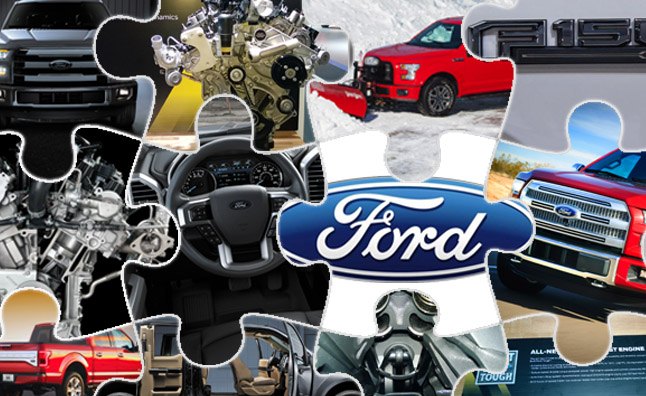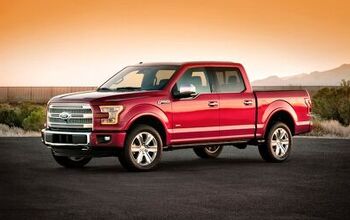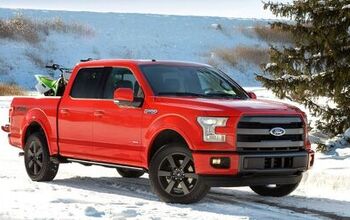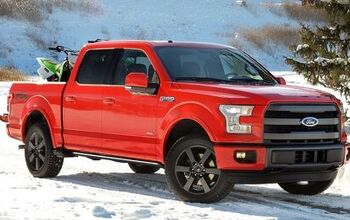2015 Ford F-150 Explored in Depth

Ford has completely redesigned its wildly popular F-150 pickup for the 2015 model year. This tough truck made its global debut at the North American International Auto Show in Detroit in January.
LIGHTing The Way
The company is taking an enormous chance with the new F-150. Breaking with tradition they’ve switched to an aluminum body in an aggressive bid to cut mass and save fuel. Traditionally the widespread use of this lightweight metal has been exclusive to top-dollar luxury cars like the renowned Audi A8.
The end result of this innovation and hard work is jaw dropping. Company representatives claim they’ve reduced the truck’s curb weight by 700 pounds. The overwhelming majority of that reduction, about 500 pound’s worth came out of the body. Engineers were able to take about 130 pounds out of the truck’s powertrain and an additional 70 out of the frame, which is now 77 percent high-strength steel, up from just 23 percent in today’s F-150.
A heavily revamped engine lineup also accompanies the new body. Ford’s immensely thirsty 6.2-liter V8 has been left to the brand’s Super Duty trucks. This means the popular and torque-rich 3.5-liter EcoBoost V6 should serve as the top offering. A familiar 5.0-liter V8 will still be available.
Beyond these changes there’s a new base engine. The F-150’s current entry-level powerplant is a 3.7-liter V6, but since the 2015 model is so much lighter they’ve been able to downsize that to a 3.5-liter six-shooter to further increase fuel economy.
SEE ALSO: Ford Reveals 2015 F-150
Even with the dip in displacement “we’ll still deliver better acceleration” said Doug Scott, truck group marketing manager at Ford. Additionally Scott said it should be “the most efficient F-150 ever,” though he declined to share any fuel economy estimates.
All-New EcoBoast V6
Aside from its groundbreaking aluminum body, this truck also features a brand-new EcoBoost V6. According to Scott it’s a “whole new engine family” and the 2015 F-150 is the first application.
Aside from direct fuel injection and turbocharging, the engine also comes with standard stop/start technology to further improve efficiency. But the company appears to have made one curious engineering omission when it comes to saving gasoline.
Paradoxically while the 2015 F-150 has an aluminum-intensive body the new 2.7-liter EcoBoost actually features an iron block. We all know ferrous metal is considerably heavier than aluminum, why would they go with such a material when they’ve bet the farm on lightweight metal for huge portions of the pickup?
While company spokes-folks wouldn’t comment specifically on this material choice, they did mention that a portion of the new engine’s block is made from an advanced metal called compacted graphite iron, CGI for short. This stuff has numerous advantages compared to either gray or ductile cast iron. Chiefly it has higher tensile strength and greater wear resistance. These benefits allow for much thinner, lighter castings ostensibly with no sacrifice in durability.
“We’ve been very smart where we’ve used CGI” Scott said by “putting the material in the appropriate place.” Other parts of the engine are constructed of aluminum.
Of course CGI is more expensive to cast and machine than regular iron but its additional strength and lower weight can offset these drawbacks. Ford already uses the material in its 6.7-liter PowerStroke diesel engine that’s available in the Super Duty line of trucks.
Still, iron is an unusual choice considering the rest of the company’s Duratec V6 engine family is constructed of aluminum. But metallurgy isn’t the only area where this engine differs from its stable mates.
Engineering Intricacies
While supposedly a completely new architecture the 2.7 appears to borrow a few features from the company’s dated 3.0-liter V6. Like this engine and the company’s Modular V8s roller-followers actuate the valves instead of flat tappets; additionally the arrangement of its timing chains mirrors the old 3.0-liter V6, with one staggered in front of the other.
Borrowing traits from the 3.5-liter family it’s got cast-iron camshafts instead of hollow steel tubes with pressed-on lobes. Variable valve timing on the intake and exhaust cams, coil-over-plug ignition modules and complexity-reducing integrated exhaust manifolds round out the top-end.
Moving to the block it’s got piston-cooling jets to keep unwanted heat at bay, a variable-displacement oil pump for greater efficiency as well as fracture-split main bearing caps, supposedly the first application of this innovation. Like the valve covers, its oil sump appears to be made from plastic. All told the new 2.7-liter EcoBoost V6 looks like a curious mix of old and new.
Manufacturers love to brag about how thoroughly they torture test their products and this powertrain is no exception. Among other rigorous trials Ford has subjected the new engine to some 240,000 starts and stops over 900 test hours. They’ve run it at peak load for 17 straight days and even conducted more than 1,000 consecutive extreme-temperature shocks that take the powerplant from minus 25 degrees to 235 degree. They even tested it in the grueling Baja 1,000 race… cleverly without anyone’s knowledge.
Output Estimates
Doing the math that works out to about 104 ponies and 120 units of torque per liter. If we multiply these figures by 2.7 we arrive at about 281 hp and 324 lb-ft, numbers that are comparable to a midrange V8.
Could this new EcoBoost engine be Ford’s lower-cost, gasoline-powered response to the Ram’s 3.0-liter EcoDiesel? That powerplant puts out somewhat similar numbers, 240 hp and 420 lb-ft. With its lightweight new body could the 2015 F-150 meet or exceed the Ram’s performance and efficiency?
Of course these figures are little more than rough estimates so don’t be surprised if Ford’s official numbers are significantly different. But aside from output, we wonder, will this engine fit under the new Mustang’s hood? That could be an interesting combination.
GALLERY: Ford 2.7-Liter EcoBoost Engine
Discuss this story on our Ford forum

Born and raised in metro Detroit, Craig was steeped in mechanics from childhood. He feels as much at home with a wrench or welding gun in his hand as he does behind the wheel or in front of a camera. Putting his Bachelor's Degree in Journalism to good use, he's always pumping out videos, reviews, and features for AutoGuide.com. When the workday is over, he can be found out driving his fully restored 1936 Ford V8 sedan. Craig has covered the automotive industry full time for more than 10 years and is a member of the Automotive Press Association (APA) and Midwest Automotive Media Association (MAMA).
More by Craig Cole






































Comments
Join the conversation
I want to know what happened to the advertisements about the 2015 F150 that would have an all new Diesel engine. Ads stated it would be the same as the 8 cylinder cut in half so parts would be mostly interchangeable and take a reliable engine and put in an all new truck. I will never buy another Gasoline engine if at all possible. I am even considering an electric lawn mower over a gasser. Gasoline is not as stable or practical as older fuel and lifespan is horrendous. If the F150 had a Diesel engine like they were hinting at we would be first in line to buy one. I love my 2000 F250SD 7.3L and would like to junk the POS 2007 Taurus. My truck actually gets better fuel mileage than the V6 in the Taurus.
The discussion about old engine technology reeks of a lack of understanding. The CGI block has very little in common with the 'cast iron' they compare it to, and as briefly mentioned is a new technology that is both more expensive and very different from 'old cast iron'. It is a technology that, to date, only Ford has employed in mainstream vehicles, at higher cost to the manufacturer. I will spare the details, but this is brand new, not old technology, and combines better strength to weight than both cast iron and aluminum. Hence the all-new engine. Also, Ford has already announced that a diesel will be in the engine lineup after the initial release. But yes, this engine should be the closest in comparison to the diesel fuel economy.